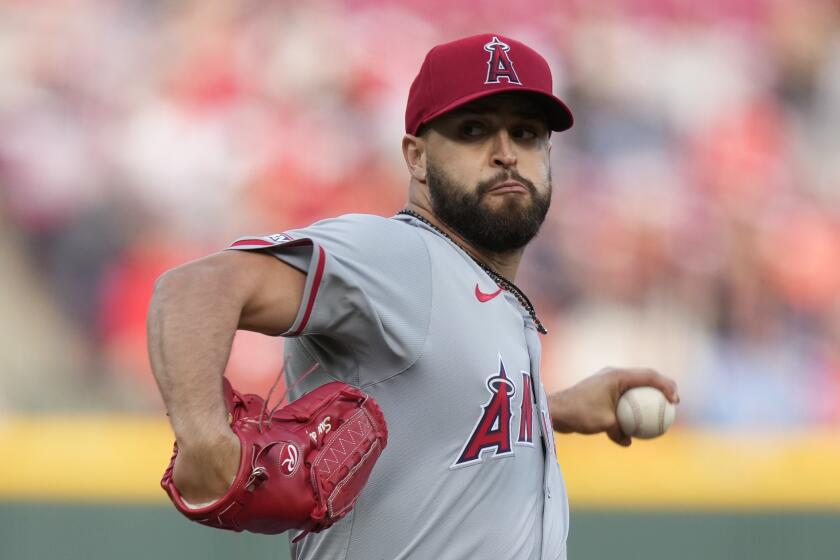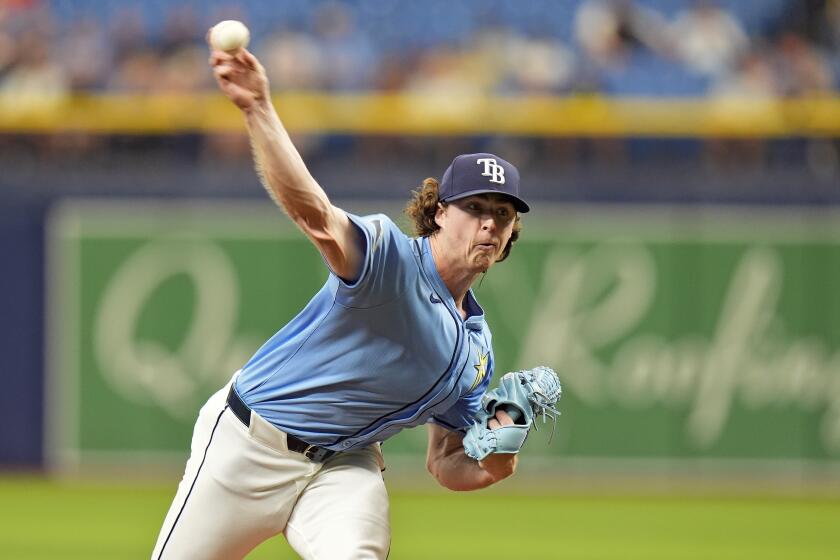Rangers are on a Ryan express
Tom Hicks needed a Texas hero to save his franchise, or so he thought.
They don’t cast heroes like Nolan Ryan anymore -- big and strong, honest and direct, pitcher, banker and rancher. Hicks, the owner of the Texas Rangers, recruited Ryan and asked him to rescue his club from the rut of sustained mediocrity.
Ryan assumed the presidency of the Rangers 16 months ago. He inherited Jon Daniels as his general manager, an odd couple at first glance.
Ryan was the Hall of Fame pitcher, the lifelong Texan, the pride of the old school. Daniels was half his age, with an economics degree from Cornell and a resume that included the donation of Adrian Gonzalez to the San Diego Padres.
Ryan stuck with Daniels, convinced the Rangers did not need to start over yet again. That patience has paid off sooner than either man imagined, with the Rangers already challenging the Angels’ dominance in the American League West, the first dividend of a game plan that could give the Angels fits for years to come.
The Angels lead the Rangers by half a game in the AL West. The teams face off six times in the next 10 days, with three games in Texas starting Monday and three in Anaheim next week.
“For a long time, this organization did not have a true identity,” Daniels said. “We have a pretty clear vision of who we are right now.”
Hicks did not need Ryan to save the franchise so much as he needed Ryan to save him from Scott Boras.
In 1999, Hicks’ first full season as owner, the Rangers won the AL West for the third time in four years. They had lost in the first round of the playoffs all three times, twice by sweep.
Boras sold Hicks on two remedies: Alex Rodriguez for $252 million and Chan Ho Park for $65 million. Rodriguez was terrific -- and, as we now know, on steroids -- and Park was terrible.
But, as the Angels learned in the late 1980s and early 1990s, spending on free agents at the expense of scouting and player development can result in a vicious cycle of mediocrity.
Fans in large markets won’t pay to see a rebuilding team, or so goes the argument. So you try to put a winner on the field every year, and you end up with a bunch of .500 teams.
In 2006, Daniels’ first year as general manager, the Rangers went for broke. They traded the unheralded duo of Gonzalez and Chris Young for veteran pitching in January, signed Kevin Millwood from Team Boras for $60 million, traded for Carlos Lee in July and finished two games under .500.
Not a disaster by any means, except for the Gonzalez trade. Yet, for the sixth time in seven years, the Rangers did not finish within 10 games of a playoff spot.
That was enough of that, Daniels decided. The time had come to turn away from the long-term contracts to free agents, to turn toward developing players from within, particularly pitchers.
For 2007, the Rangers hoarded draft picks. They let Gary Matthews Jr. go and got two picks from the Angels. They let Lee go and got two picks from the Houston Astros. With their five first-round picks that year, the Rangers selected four pitchers.
They signed Eric Gagne and Kenny Lofton to one-year contracts, then traded them in July for prospects -- Gagne to the Boston Red Sox for David Murphy, now a starting outfielder, and Lofton to the Cleveland Indians for top catching hopeful Max Ramirez.
And, in what might turn out to be the best trade of the decade, they bid farewell to Mark Teixeira. Hicks first offered him $140 million, Boras said no, and the Rangers traded their best player to the Atlanta Braves, 15 months before he would become a free agent.
Teixeira got $180 million from the New York Yankees, so he won. But so did the Rangers, with this return: Elvis Andrus, now their shortstop; Jarrod Saltalamacchia, now their catcher; Matt Harrison, now in their starting rotation; and Neftali Feliz, just converted to a reliever at triple A in the hope he might provide the late-season bullpen boost that Francisco Rodriguez did for the Angels in 2002.
“You’re not going to find a better arm,” Daniels said of Feliz.
The rebuilding took some time, although not as much time as the Rangers thought. Even after Daniels traded for slugger Josh Hamilton last year, he hoped Texas could contend again in 2010.
The attendance did fall, to 1.9 million last year, from 2.9 million a decade earlier. However, as Daniels learned -- and subsequently explained to Ryan -- the fans would support a long-term plan so long as management would explain what it was, and why it ought to work.
“We probably have a culture of fans, unlike most clubs, that are exceptionally in tune with our minor league teams and players,” Daniels said. “We almost get more backlash when we talk about trading our guys than otherwise.”
Ryan set about erasing the good-hit, no-pitch caricature of the Rangers. The Rangers posted a 5.37 earned-run average last season, worst in the major leagues. Their starters pitched the fewest innings of any rotation in the majors.
They used a club-record 30 pitchers, for the third time in five years. They put 15 pitchers on the disabled list, a number Ryan aimed to cut by about half.
Ryan recruited Mike Maddux, regarded as one of the best pitching coaches in baseball, from the Milwaukee Brewers. Then he and Maddux put the pitchers to work at two off-season mini-camps, on programs designed to carry them through the heat of a Texas summer.
More throwing. More running. More work on legs and abs in the weight room. No more getting tired just because it’s July, or because it’s 100 degrees outside, or especially because you hit 100 pitches.
Ryan understands that studies have shown injury risks can rise as pitchers work beyond 100 pitches. What he does not understand, he said, is how a general guideline evolved into orthodoxy.
“You can’t make a broad brushstroke and say that’s where everybody needs to be,” Ryan said. “Their workloads are different. Their bodies are different. That’s the way it had been approached, and that’s what we have to get back to.
“Let the pitching coach learn his pitchers and what their capabilities are.”
So far, so good. Millwood, on the disabled list four times in the last two years because of hamstring and groin injuries, leads the majors innings pitched. The Rangers have a 4.39 ERA, and their starters ranked third in the league in innings.
The Rangers have been here before. They had a winning record at the All-Star break in three of the last four years, but they finished with a losing record every time, in large part because their pitchers wilted.
“You don’t really know how people will handle it,” Ryan said, “but I suspect we’ll be in better shape than we were last year.
“We know we’re going into the toughest part of the year, with the heat like it is, and it is the second half of the season. That’s what separates a lot of people.”
Perhaps the Rangers will not separate themselves from the Angels this season, but woe to the pitcher who tells Ryan he can’t handle the summer.
The Rangers will be Texas tough, and that’s a start.
--
More to Read
Go beyond the scoreboard
Get the latest on L.A.'s teams in the daily Sports Report newsletter.
You may occasionally receive promotional content from the Los Angeles Times.






